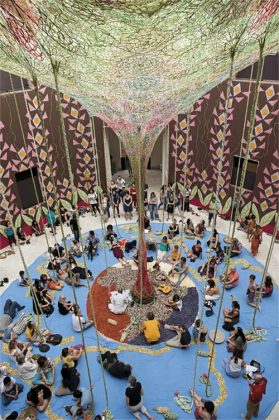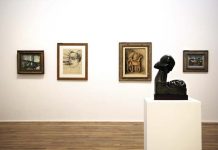Few artists can update the radicality of Brazilian artistic production, where the body was part of the work, in the 1960s and 1970s, as Ernesto Neto. This is what can be seen in the Sopro show, which is on display at the Pinacoteca do Estado de São Paulo until July 15.
In his works and in an original way, Neto manages to gather both the proposals of collective experiences of Hélio Oiticica (1937 – 1990) in his Penetráveis, when he sought to create spaces for coexistence, as to the activations of the body through experiments with different materials, such as proposed Lygia Clark (1920 – 1988) in her Objetos Relacionais.
However, whereas 50 years ago these practices sought to reformulate the foundations of art, Neto, already free of this burden, has been working on a more current and necessary agenda: a “project of indigenization of life” in the definition of Els Lagrou, anthropologist and teacher of UFRJ, in the show catalog.
At the Pinacoteca, this practice is embodied in the installation of the octagon, Cura Bra Cura Té, which hosts five participatory activations open to the public throughout the exhibition period. The next ones take place on June 29 and July 13.
The relationship between the artist and the indigenous issue has been the subject of debate in recent years, especially when he participated in the Venice Biennale two years ago. The controversies are summarized in the question: What is the legitimacy of a white artist to appropriate the discourse of other peoples and cultures? Understanding the place of speech is currently one of the challenges of any kind of discourse that seeks to “represent” the other.
Undoubtedly it is a bit strange when artists portray themselves as Indians and sell or expose these paintings without any major commitment to the issue. We are there in the field of mere representation, and it was exactly against this kind of posture that Oiticica and Clark rebelled.
Since 2013, however, Neto has been involved with the huni kuin people in Acre in an engaged way, participating in their rituals and incorporating them to their shows, in Brazil and abroad, as happened in Venice.
This participation, in Sopro, occurs in the octagon, in the activations around a large trunk “that needs to be cured” and, for that, is swallowed by an immense pendant.
“We are children of three continents, but we know of one, they only teach us one, we value only one”, writes Neto on the walls of the show, explaining the dazzle with the European culture of the “Brazilian crudes”, as Christian Dunker brilliantly defined in text published in ARTE!Brasileiros digital plataform.
“The time has come to listen to the spirituality of our land, our plants, rivers and trees, the time has come to listen”, argues the artist. It is here that this project of indigenization is made explicit, since the so-called forest peoples seek the intrinsically relational quality of every being, human and not human, what Lagrou defines as “Amerindian relational aesthetics.”
“It’s time to listen to pajés, babalorixás, yororixas”, says Neto, and the programming of activations covers these silenced voices in the history of Brazil, but which in recent decades has been gaining space. They are now at the Pinacoteca not only as a proposition of the artist, but as a consequence of the struggle that these people have been engaging.
Breath, however, goes far beyond the octagon and, in the various spaces where it occurs, reveals how it makes sense in Neto’s career the poetics he now defends.
This harmony with an indigenist cosmogony, where human and nonhuman are seen as part of a whole, after all is central in its various facilities, which ask for the presence of the other, that contaminate the environment with odors, that facilitate the encounter, that touch, caress and envelop.
The plasticism seen in the works of the 1980s to the first decade of the 21st century is dazzling: in forms, materials, volumes and dimensions. There is an organic structure in its language comfortable to all senses, which is even rare in contemporary art. But the maximum power now arrives in this “indigenist project”, politicizing what was discreet at once, and transforming Ernesto Neto into a kind of shaman in times of cholera.













